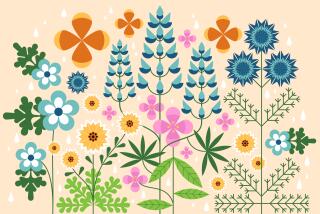The 10 Essential Tasks
- Share via
1. Fertilize everything. Most plants do their growing in spring, so fertilizing now--even if it’s the only time you ever feed--will make a huge difference. The kind of fertilizer used isn’t very important, as long as you do it.
*
2. Stop weeds in lawns. Crab grass can overrun lawns in summer, as can cloverlike oxalis. Prevent seed from even germinating with a preemergent herbicide that is most often mixed into lawn fertilizer. Look for bagged products like Bandini Pre-Sprout 1 (which stops oxalis and other broadleaf weeds from germinating) or Pre-Sprout 2 (which stops grass seed, such as crab grass).
*
3. Reseed lawns. Lawns get a little thin in winter, so fatten them up by sowing more seed right on top. Use seed similar to the variety that predominates in your lawn. Obviously, you cannot use a preemergent herbicide like those mentioned above if you’re trying to sprout grass seed.
*
4. Inspect irrigation. Now’s the time to make sure that sprinklers work, not when temperatures soar into the 100s. Check to see that nozzles are clean, that heads aren’t broken and that they’re in the right place. If sprinklers aren’t evenly irrigating beds or lawns, now’s the time to dig them up and relocate lines.
*
5. Plant--or feed--citrus. When should you plant citrus? Right now. They’re happiest planted in a warming soil. Just be sure to keep them watered. This is also a good time to lightly fertilize established trees and perhaps to give them a little supplemental iron if their foliage is yellow.
*
6. Plant peppers. Tomatoes get all the press, but peppers are perhaps even more useful, and they’re easier to grow. With few diseases, they will produce with less heat and bear well into fall. They last for such a long time, they may need staking as they get bigger and more full of peppers. There are all kinds, from extra hot to mild. If you can only plant one, try the versatile ancho.
*
7. Sow seed. If you can’t find plants at nurseries (for instance, ancho peppers are often hard to find), this is a great season to start seeds. In ordinary potting soil and in a partially shaded spot outdoors, simply keep seed moist and it will sprout. The only precautions: Use fresh seed and don’t plant it too deep.
*
8. Repot patio plants. If a plant has been in its container for a year or more, it probably needs repotting, easily done while the weather is still mild. Knock the plant out of its pot, untangle and trim some of the roots, put a wire screen over the drainage hole, add a little potting soil to the bottom and put the plant back in. Or, move it up a size to a pot that is 2 to 4 inches wider.
*
9. Shop for summer flowers. Nurseries are full of bedding plants and annual flowers, everything from asters to zinnias. They will provide temporary summer color if planted soon, although some--such as impatiens and rudbeckias--may last several years. (But even they look better replanted every spring.) For garden beds, buy the smallest sizes of bedding plant you can find. After being planted, they will grow to become the largest because their roots are less constricted.
10. Try browallia. Most gardeners fall back on impatiens every summer for color in the shade, but look for browallia instead. The plants are similar to lobelia, about a foot tall, and they are a bright, true blue. Like impatiens, they prefer shade, warmth and moisture. Your blue flowers will make neighbors with pink impatiens green with envy.






